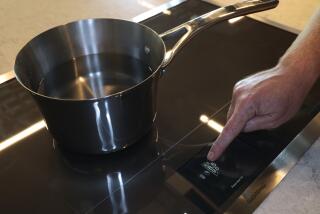All that snazz
- Share via
IF your last kitchen remodeling project dates back to the Bicentennial, it’s easy to swoon when you walk into a new appliance showroom. There, among the cabinetry-fronted Sub-Zeros and Sherman tank-like Viking stoves, you can be seduced into thinking, “This would look great in our kitchen.”
But before you whip out the credit card, consider whether your kitchen is ready for the latest models.
“This is something I’ve seen happen over and over again,” said Jennifer Salisbury, general manager of Blue Ribbon Design-Build in Lake Forest. “People see the prices on some of these bigger, new appliances and figure they can handle it. Then they find out that to install them it’s going to cost thousands more.”
Unfortunately, that’s the hidden cost of buying appliances that are cover stars in upscale home magazines. Depending on your home’s infrastructure, adding a sleek new refrigerator or designer range could mean paying thousands for electrical or gas-line upgrades or changes to your existing kitchen cabinetry.
In recent years, the professional-style gas ranges and ovens by companies such as Viking and Wolf have become staples of upscale kitchens. Of course, these culinary beauties have prices to match their looks, costing $3,100 and up for a standard, 30-inch-wide model. A regular Sears Kenmore porcelain-finish gas range of the same size can be had for as little as $380.
In refrigerators, the Sub-Zero built-in has long been a symbol of kitchen chic. Other appliance manufacturers such as Jenn-Air, GE and KitchenAid also sell their own styles of built-ins, which can be designed with doors that match a kitchen’s cabinets. Expect to pay about $4,500 for a “small” 21-cubic-foot model. By comparison, a similar-sized Whirlpool double-door fridge that will roll into the old refrigerator bay can be found for about $1,100. You might even get one with an ice and water dispenser on the door.
“There’s definitely a snob appeal to these big products,” said Larry Nickles, a Van Nuys-based appliance installer. “People see their neighbors adding a built-in refrigerator and they feel they need to keep up. It’s not that they need more refrigerator space or that they’re eating more.”
To fit one of these super appliances into the kitchen, there’s generally some remodeling work needed, such as a realignment or replacement of the kitchen cabinets and counters, which can cost from a few hundred dollars to move a cabinet to a high-four-figure remodel.
“Most homes built since the 1970s have a three-fourths-inch gas line running through the house. But some older houses still have a one-half-inch line,” said Raymond Hebert of Benedict & Benedict Plumbing in Pasadena. If your new range requires a three-fourths-inch line, it might fit in the space but it won’t work at maximum performance because not enough gas is getting through.
Gas lines may need to be replaced or a dedicated gas line may have to be laid from the meter to the stove, which can add $1,000 to the cost of the appliance.
Another issue is the venting. Bigger ranges and grills need a fan to draw heated air and exhaust out of the kitchen. A standard kitchen fan from an ‘80s tract house will generally vent at a speed of about 250 to 300 cubic feet per minute. A professional-style range may require a fan with 600 to 1,200 speed.
Ductwork may need to be replaced. That 1,200-speed fan needs a 10-inch duct to operate effectively, Nickles said.
A mid-20th century home that needs a 21st century kitchen appliance could also require some electrical upgrades. New electrical industry codes state that every appliance needs its own circuit, which, if you don’t have room on your electrical panel, means replacing that too, said Blue Ribbon Design-Build’s Salisbury.
Many homes built in the 1950s and ‘60s had panels that went up to 100 amps, which at the time was considered more than enough to run the house’s appliances. But for homeowners who added electrical power suckers such as spas, pools and air conditioning, those 100-amp panels are near or at their capacity. An upgrade to a 200-amp panel, costing from $1,000 to $1,500, is generally a necessity for a remodeling project.
Even contractors can underestimate the infrastructure upgrade costs when putting in new appliances.
“We had a job early on in our business where we told a customer, ‘Sure, we’ll throw in a refrigerator installation with your kitchen remodel,’ ” Salisbury said. “Then we found out there needed to be some new wiring and cabinet work, which went way beyond what we had budgeted for the job. So, we don’t do that for free anymore.”
On an older home, even what seems like a standard feature, such as a refrigerator ice-maker, can add a few hundred dollars to the cost of a simple new fridge if the refrigerator bay isn’t plumbed for an ice-maker waterline.
Overall, when shopping for super appliances, it’s probably best to remember the “99%” rule.
“A big, shiny new range or refrigerator will make 99% of your kitchen look old and outdated,” Nickles said. “If you’re looking at these, you should also be thinking about cabinets, flooring, counters, etc., and get them all done at once.”
*
(BEGIN TEXT OF INFOBOX)
Consider this ...
Thinking of springing for new appliances? If your older home isn’t up to the task of supporting them, factor in these costs of updating:
Venting fan: $250 to $500
Vent ductwork: $300 to $1,000
Dedicated gas line: $350 to $1,000
Electrical upgrade to a 220-amp panel: $1,000 to $1,500
Ice-maker waterline: $100 to $300
-- John Morell


